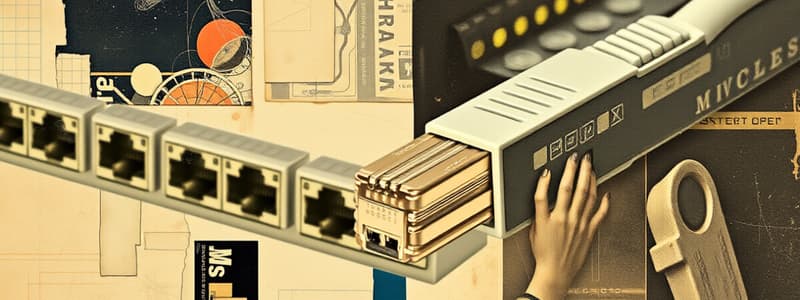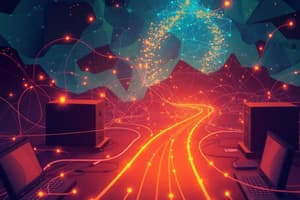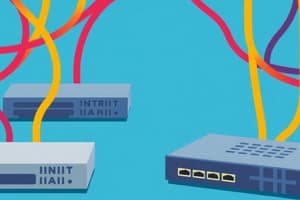Podcast
Questions and Answers
What is the primary function of a server in a network?
What is the primary function of a server in a network?
- To connect different networks together
- To deliver information and software to other connected devices (correct)
- To act as a client for other nodes
- To limit the resources available to users
Which of the following best describes a node or client in a network?
Which of the following best describes a node or client in a network?
- A device that only sends data
- A security system protecting network resources
- A server that manages network traffic
- Any system or device connected to a network (correct)
What is the primary function of a switch in a computer network?
What is the primary function of a switch in a computer network?
- To serve as a storage device for network data
- To connect multiple devices on a network more intelligently than a hub (correct)
- To amplify signals over long distances
- To provide wireless connectivity to devices
What role does a Network Interface Card (NIC) play in a network?
What role does a Network Interface Card (NIC) play in a network?
Which type of network typically covers a range of about 10 meters?
Which type of network typically covers a range of about 10 meters?
Which component is used to connect various devices into a network?
Which component is used to connect various devices into a network?
Which of the following is NOT a type of cable used in computer networking?
Which of the following is NOT a type of cable used in computer networking?
What distinguishes a dedicated server from a non-dedicated server?
What distinguishes a dedicated server from a non-dedicated server?
What is a characteristic of a Local Area Network (LAN)?
What is a characteristic of a Local Area Network (LAN)?
Which of the following devices can be typically found in a Personal Area Network (PAN)?
Which of the following devices can be typically found in a Personal Area Network (PAN)?
Flashcards are hidden until you start studying
Study Notes
Networking Basics
- A hub connects multiple ports that devices use to join a network.
- A switch intelligently connects devices within a network, managing data traffic more efficiently than a hub.
Cables
- Cables are essential for connecting network devices and transferring data.
- Types of cables include:
- Coaxial cables
- Twisted pair cables
- Fiber optic cables
- Patch cables
- Data cables
Network Resources
- A network comprises various resources, such as printers, disks, scanners, and memory, shared among connected computers for optimal utilization.
Types of Networks
- Computer networks are categorized based on communication needs, geographic area, and hardware.
Personal Area Network (PAN)
- PANs connect devices within approximately 10 meters, suitable for home or small offices.
- Common devices in a PAN include laptops, smartphones, tablets, wearables, and printers.
Local Area Network (LAN)
- A LAN connects numerous computers within a limited area, typically within 1 kilometer.
- Commonly found in schools, offices, and research institutions, it utilizes either wired or wireless connections.
Server Requirements
- Dedicated servers exclusively serve a single task, while non-dedicated servers share resources among multiple users.
Nodes or Clients
- A node or client is any device connected to a network. For example, a network with a file server, five computers, and two printers has eight nodes.
- Each node has a unique network address for identification.
Network Interface Card (NIC)
- A NIC, or Ethernet card, connects computers and devices via Ethernet cables.
- It is crucial for enabling communication and resource sharing in a network.
Connectors
- Connectors assist in linking components such as hubs, switches, and servers with computers through cables.
Switch/Hub
- A switch or hub serves as a device for connecting multiple devices to a network.
- The term internet (with a lowercase 'i') refers to interconnected smaller networks, while the Internet (capital 'I') denotes the global network encompassing millions of web pages, emails, and servers.
Network Topology
- Network topology outlines the physical and logical arrangement of devices, aiding in node location and data transmission.
- Common topologies include:
- Bus Topology: All devices connect along one cable, making the entire network prone to failure if the cable is damaged.
- Star Topology: Devices connect to a central server; if one cable fails, only the connected device is affected. It is the most prevalent topology in LANs.
- Ring Topology: Nodes are arranged in a circular layout, with data flowing in one direction. A failure in any connection disrupts the entire network.
Studying That Suits You
Use AI to generate personalized quizzes and flashcards to suit your learning preferences.




